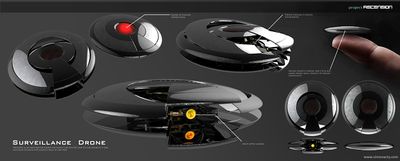No edit summary |
No edit summary |
||
| Line 2: | Line 2: | ||
[[File:{{#setmainimage:srts-drone.jpg}}|400px|center]] | [[File:{{#setmainimage:srts-drone.jpg}}|400px|center]] | ||
The short range tactical surveilling drone is only 2.5 cm in diameter. It is powered by a | The short range tactical surveilling drone is only 2.5 cm in diameter. It is powered by a [[Spacial Variance Reactor]] at its core powering a simple anti-gravity array allowing it to fly in most environments. It has a range of about 150 km and a maximum speed of around 5 kps. It is designed to be exceptionally small and maneuverable, the built in simple AI seeks out the best vantage point where it can gather the most data. Usually the drone will automatically seek to stay as close to its maximum range from its host launcher as possible in the direction of travel to provide the most data. The battery life span is about 6 hours, though it can find compatible power sources and absorb power through inductive charging. If left completely on automatic and the drone was not previously directed not to, it will seek out a way to replenish its power supply. | ||
The device is built out of a sensor-resistant material, the size and material make the drone nearly undetectable. | The device is built out of a sensor-resistant material, the size and material make the drone nearly undetectable. | ||
Revision as of 17:02, 27 March 2018
There are multiple variants of this technology, please refer to Drone Disambiguation for a list of the variants. |

The short range tactical surveilling drone is only 2.5 cm in diameter. It is powered by a Spacial Variance Reactor at its core powering a simple anti-gravity array allowing it to fly in most environments. It has a range of about 150 km and a maximum speed of around 5 kps. It is designed to be exceptionally small and maneuverable, the built in simple AI seeks out the best vantage point where it can gather the most data. Usually the drone will automatically seek to stay as close to its maximum range from its host launcher as possible in the direction of travel to provide the most data. The battery life span is about 6 hours, though it can find compatible power sources and absorb power through inductive charging. If left completely on automatic and the drone was not previously directed not to, it will seek out a way to replenish its power supply.
The device is built out of a sensor-resistant material, the size and material make the drone nearly undetectable.
Sensors
It has a multi-optic camera that can see in wavelengths of light from the infra-red all the way up to microwaves. Detectors on board can also detect near-by radio and subspace energy sources. Sensor data is relayed back to the source using a subspace datalink, the most data can be transmitted within the 150 km range along with the primary control signal. However, the drone is capable.
Communications
The done's size limits its communications ability. The primary communications system is a very high fidelity rapid-response system which allows a full real-time control signal and data link up to a range of 150 km. The secondary communications system is slower and has far lower bandwidth forcing the drone to transmit data in bursts over a wider band, this uses more power and only supports a directive-based rather than a flight-control based control of the drone. The secondary signal can reach orbital and even interplanetary space, however.
If a relay point or other receiver is linked within the 150 km, the drones secondary array will be inactive to conserve power.
Command / Control
The unit has only a basic AI and thus it is most useful when under external control. The primary control signal has a max range of 150 km, which allows total control of the unit. However, a secondary control signal can direct the AI to target a location or track a particular target which can be done from significantly farther away.
Signal Loss
In the event the drone is unable to lock onto a friendly signaling station, it will attempt to return to its host / launch origin. Should that be impossible, it will attempt to land and await further instructions to conserve power.